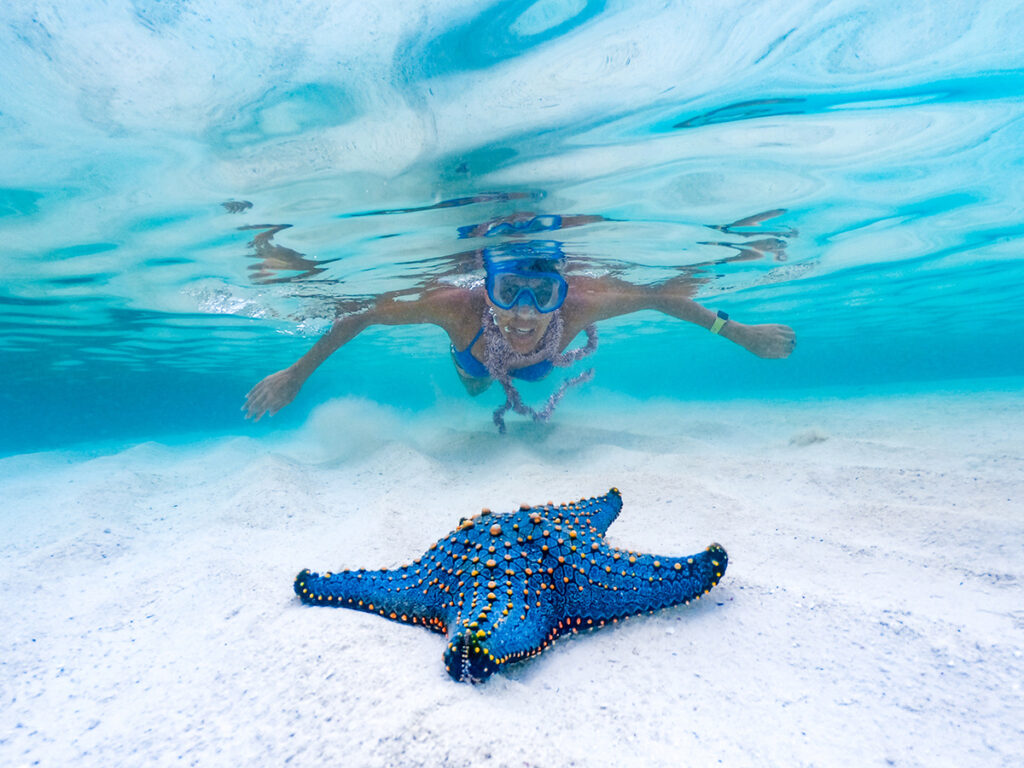Discover Starfish beach, a quiet and relaxing atoll where you’ll find a rainbow of tropical fish just beneath the surface.
What is included?
-Snorkeling Equipment’s
-Fresh fruits & Bottled water
-Professional guide
Sites to visit near Blue Lagoon
A visit to Blue Lagoon should be maximum 3 hours so it is ideal to add up other sites nearby. Listed below recommended sites to add to your itinerary top to low
The Rock Restaurant Zanzibar
Take a break from sightseeing with a Lunch/drink at The Rock Restaurant. The Rock restaurant in Zanzibar, provides a unique dining experience like no other. Situated on top of a rocky outcropping adjacent to Pingwe beach, during high tide the restaurant appears to float in the water. During our recent visit to Zanzibar we knew we had to experience a meal at this restaurant.

Paje beach
Visit dazzling Paje Beach. You can focus on relaxing, sunbathing, and swimming in the crystal-clear water. Paje is one of the best beach where you can enjoy the white sandy beaches and shallow water that can be ideal for snorkeling, swimming and relaxing on the beach or even kitesurfing.

Jozani Forest National Park
Established as a conservation area in the 1960s, the Jozani Forest is now part of Zanzibar’s Jozani-Chwaka National Park, and has become an important sanctuary for one of the rarest primates in Africa: Kirk’s red colobus monkeys. There is also A mangrove boardwalk gives tourists the possibility to have a view into the special mangrove habitat which could be enjoyable.

Kuza Cave
Zanzibar’s best kept secrets – Kuza Cave – an ancient limestone jungle cave with crystal clear turquoise fresh water. You won’t want to leave so why not buy the package deal and stay for the day.
There is easy access to the large light-filled circular cave and a reception area with a restaurant and large shaded area where you can buy food and drinks. The area around the cave is a peaceful nature preserve for wildlife that includes Red Colobus Monkeys, colourful butterflies, many birds, chindi and bush babies.

Starfish, also known as Sea Stars, are one of the most beautiful looking animals in the vast ocean. They have a surprisingly unusual anatomy, with no brain or blood, yet are able to digest food outside their body. Regenerating their own arms is perhaps one of the most useful things a starfish can do.
Starfish can regenerate their own arms
Regenerating their own arms is perhaps one of the most useful things a starfish can do. This attribute can be used in many different ways. Arms can be lost when a starfish comes in contact with a predator, or it may be amputated in order to hide or escape from one.
Arms can take months, even years to fully regenerate, so it has to be a pretty serious situation to lose one. Incredibly, if the severed leg is not harmed, it can heal itself and even regenerate – resulting in a genetically identical starfish. Pretty cool, right?
They have no brain or blood!
With no brain or blood it seems crazy to think starfish can survive in the depth of the vast ocean. However, they find very clever and simple ways to get around it.
Seawater is pumped throughout their body as a replacement for blood, with the water delivering key nutrients to the starfish allowing its organs to function properly. The use of water saves space as there is no need for a complex blood system, also since seawater is highly abundant they will never run out of it.
Starfish may have no brain, but they are certainly not fools!
They wear tough, leathery skin
Starfish are layered with an upper skin made out of calcium carbonate. This strong material makes the skin tough and difficult for hunters to breakdown.Some species of starfish will even go a step further with the addition of numerous spines on their skin, acting as a layer of armour to deter predators.
Starfish have eyes
Lacking a brain, blood and even a central nervous system, it might come as a surprise to you that starfish have eyes. Just to further add to their unusual anatomy, their eyes are on the end of their arms. Whilst their eyes may not be able to see in fine detail like our eyes can, they are able to detect different shades of light allowing them to navigate their surroundings – allowing them to hunt for food and hide from predators.
Starfish move with hundreds of feet
Starfish are equipped with hundreds of tiny little feet at the end of each arm.To move, they fill these feet with seawater, causing the arm to move like a foot would. This mechanism allows the starfish to move – much quicker than you might expect. Visit our rock pool to see this first hand!
Starfish can eat outside their body
Due to their tiny mouth on the underside of their body, starfish have adapted an ingenious way of eating things larger than it can fit in their mouth. They have a stomach that can digest food outside their body, so that it can fit in their mouth. This allows the food to be further broken down inside the body.
Not all starfish are star shaped
Almost all starfish are shaped like a star, which is how they get their grouped name. However, there are a few special cases.The Cushion Starfish has a round blob-like shape, while having all the genetic qualities needed to be a starfish. This starfish is actually much gentler than other starfish, feeding on detritus and plants. Other starfish will tend to feed on clams or oysters. src

